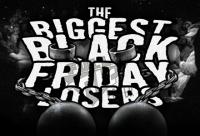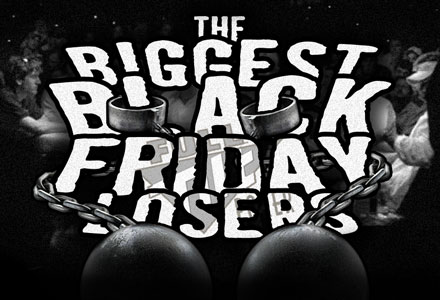 This weekend marks the one-year anniversary of Black Friday. The number of entities that have gained from shutting down is a small one, limited mostly to a handful of figures advancing their political careers and a small number of American gaming companies who could potentially make a lot of money if they were to take over the market. The list of Black Friday losers is much longer. Here’s a look at some of the parties most affected over the last year by the DOJ’s shutdown of online poker in America.
This weekend marks the one-year anniversary of Black Friday. The number of entities that have gained from shutting down is a small one, limited mostly to a handful of figures advancing their political careers and a small number of American gaming companies who could potentially make a lot of money if they were to take over the market. The list of Black Friday losers is much longer. Here’s a look at some of the parties most affected over the last year by the DOJ’s shutdown of online poker in America.
1. Full Tilt Poker
On Black Friday it wasn’t clear yet how everything would shake out with regard to the sites named in the DOJ’s indictments. At the time Full Tilt Poker was a respected name in the business and had all the appearances of being a successful company, so there was no reason to expect that there wasn’t enough money to cover its players’ balances. There was even less reason to expect the debacle that the DOJ-brokered sale of the company to Groupe Bernard Tapie became. The breach of trust at Full Tilt, and the fallout from it, will be a black mark on the reputations of its principals for a long time to come.
Speaking of the people in charge of Full Tilt, they lost out on a lot more than just public goodwill. They clearly had a very, very good thing going for themselves financially, taking millions of dollars out of the company while it operated without enough cash on hand to cover player balances. If Black Friday hadn’t come along they conceivably could have continued to keep the room afloat for at least the near term. That would have allowed them to either right the ship or continue taking more money out of the company, either of which would have been much better for them than being indicted.
2. American Poker Players
Americans who played recreationally had their pastime ripped right out from under them. Overnight the American online poker marketplace was reduced to free-play offerings, subscription-model “no gambling” sites, and a handful of smaller real-money room willing to continue operating in spite of a clearly aggressive DOJ. For many, there may as well have been no poker at all.
Those who played professionally were confronted overnight with more consequential decisions than most of them had ever faced down at the tables. Online poker had opened up opportunities for all sorts of smart young Americans dissatisfied with what the modern labor market had to offer them. Now that those opportunities had dried up, what to do? Continue to play online poker, but leave your home country to do so? Stay home and switch to live poker, or even change careers?
Regardless of why they played, a pretty significant chunk of American players are still out money, too. Anyone who had money tied up in any of the Black Friday rooms other than PokerStars is still waiting for a refund, which may or may not ever come.
3. International Poker Players
Poker players all around the world have continued to play online over the last year, so they’re not as bad off as their American counterparts are. The environment they’ve playing in, though, has changed just as significantly since Black Friday as it did after UIGEA was first enacted back in 2006.
The number of players online at any given time today is much lower than it used to be. That has deep effects throughout the online poker economy, whether that means smaller guarantees, changes in the rake, elimination or reduction of rakeback, or changes to players’ club programs. On their own those effects would be bad enough, but making it all even worse is the fact that the country that left the marketplace happens to be the richest in the world.
Though there are arguably more great poker players from the US than anywhere else in the world, not all of its citizens are fearsome warriors at the virtual felt. A lot of them (some people would even say most of them) are fish. Sharks all over the world felt the pinch when they found themselves suddenly swimming in a smaller, less reliably stocked pond. They’re all hoping that when the United States allows it players back online, there won’t be a wall between them and the rest of the world.
4. Ancillary industries
Unlike most other forms of gambling, a poker player can actually become better over time with some study and hard work. That’s what makes it possible to define people as good or bad poker players. So unlike with, say, online bingo, where being good means being lucky, online poker spurred the development of a market of ancillary products designed to help players improve their game.
Books, training videos, coaching services, and analytical software packages all sold well in the United States after Chris Moneymaker convinced an entire country that it could bluff its way to easy money at the tables. The bottom dropped out of the market for all that knowledge on Black Friday, when knowing your way around the felt suddenly became much less valuable to an awful lot of people.
5. American TV poker programming
As the triumph of reality programming over scripted shows attests, there’s nothing TV networks love better than programming that’s cheap to produce. And when it comes to cheap, there’s not many kinds of programming that come in ahead of poker. The players put up their own money and it’s nearly unheard of for sponsors to kick in anything extra. Production costs are minimal; a studio floor, a poker table, cameras, lights, and microphones are enough to get you going. Perhaps best of all, a little creative editing can save even the dullest table from becoming unwatchable.
In recent years much of the poker programming on American television came in the form of “time buys,” where a sponsor purchases airtime much like it would advertising and then puts on its own production. There’s no risk for the network, which makes it money up front and doesn’t worry about ratings, and the sponsor gets wide exposure for a fixed price. Poker After Dark, which was produced by the Full Tilt PR machine, was a good example of time-buy programming that disappeared after Black Friday. Since most of the time-buy poker programming in the U.S. was funded by PokerStars and Full Tilt, there’s been very little of it on American television over the last year. The Epic Poker League’s deal with CBS was an exception, but the bankruptcy of Epic’s parent company has exiled the EPL, too, to TV poker purgatory.
Essentially all that’s left for poker fans to watch on American TV these days is what they had back in 2003: the World Series of Poker and the World Poker Tour. That’s not bad, especially given the quality of those productions and the current state of the market, but it’s a far cry from the game’s heyday.
